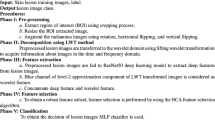Abstract
Automated melanoma classification remains a challenging task because skin lesion images are prone to low contrast and many kinds of artifacts. To handle these challenges, we introduce a novel and efficient method for skin lesion classification based on the machine learning approach and sparse representation (SR) in the quaternion wavelet (QW) domain. Further, we investigate the application of the SR approach with low, high, and mixed wavelet frequencies. Using QW coefficients, the classification problem is mapped onto the algebra of quaternions. Using the public skin lesion image datasets ISIC2017 and ISIC2019, we experimentally validated that creating dictionary with quaternions of low-frequency wavelet sub-band leads to the most accurate classification of skin lesions to melanoma or benign. We compared our approach with contemporary methods including neural networks.


Similar content being viewed by others
References
Astudillo, N.M., Bolman, R., Sirakov, N.M.: Classification with stochastic learning methods and convolutional neural networks. SN CS 1(3), 1–9 (2020)
Barata, C., Celebi, M.E., Marques, J.S.: A survey of feature extraction in dermoscopy image analysis of skin cancer. IEEE JBHI 23(3), 1096–1109 (2018)
Beck, A., Teboulle, M.: A fast iterative shrinkage-thresholding algorithm for linear inverse problems. SIIMS 2(1), 183–202 (2009)
Bulow, T.: Hypercomplex spectral signal representations for the processing and analysis of images. Ph.D. thesis, Christian-Albrechts-U. zu Kiel (1999)
Chan, W.L., Choi, H., Baraniuk, R.G.: Coherent multiscale image processing using dual-tree quaternion wavelets. IEEE TIP 17(7), 1069–1082 (2008)
Codella, N., Cai, J., Abedini, M., Garnavi, R., Halpern, A., Smith, J.R.: Deep learning, sparse coding, and SVM for melanoma recognition in dermoscopy images. In: Int. Workshop on Machine Learning in Medical Imaging, pp. 118–126. Springer (2015)
Codella, N.C., Gutman, D., Celebi, M.E., et al.: Skin lesion analysis toward melanoma detection: a challenge at the ISBI 2017, hosted by the ISIC. In: IEEE 15th ISBI, pp. 168–172 (2018)
Combalia, M., Codella, N.C., Rotemberg, V., Helba, B., Vilaplana, V., Reiter, O., Carrera, C., Barreiro, A., Halpern, A.C., Puig, S., et al.: Bcn20000: dermoscopic lesions in the wild (2019). arXiv:1908.02288
Dubitzky, W., Granzow, M., Berrar, D.P.: Fundamentals of Data Mining in Genomics and Proteomics. Springer, Berlin (2007)
Girard, P.: Quaternions, Clifford Algebras and Relativistic Physics. Springer, Berlin (2007)
Jerant, A., Johnson, J., Demastes Sheridan, C., Caffrey, T.: Early detection and treatment of skin cancer. Am. Fam. Phys. 62(2), 357–368 (2000)
Jolliffe, I.: Principal Component Analysis. Springer, Berlin (2011)
Li, Y., Shen, L.: Skin lesion analysis towards melanoma detection using deep learning network. Sensors 18(2), 556 (2018)
Moradi, N., Mahdavi-Amiri, N.: Kernel sparse representation based model for skin lesions segmentation and classification. Comput. Methods Progr. Biomed. 182, 105038 (2019)
Ngo, L.H., Luong, M., Sirakov, N.M., Le-Tien, T., Guerif, S., Viennet, E.: Sparse representation wavelet based classification. In: 25th IEEE ICIP, pp. 2974–2978 (2018)
Oliveira, R.B., Papa, J.P., Pereira, A.S., Tavares, J.M.R.: Computational methods for pigmented skin lesion classification in images: review and future trends. Neural Comput. Appl. 29(3), 613–636 (2018)
Pollastri, F., Parreño, M., Maroñas, J., Bolelli, F., Paredes, R., Ramos, D., Grana, C.: A deep analysis on high resolution dermoscopic image classification. IET Res. J. (2021)
Rebouças Filho, P.P., Peixoto, S.A., da Nóbrega, R.V.M., Hemanth, D.J., Medeiros, A.G., et al.: Automatic histologically-closer classification of skin lesions. CMIG J. 68, 40–54 (2018)
Rastgoo, M., Lemaître, G., et al.: Classification of melanoma lesions using sparse coded features and random forests. In: Medical Imaging 2016: CAD. Int. Society for Optics and Photonics (2016)
Riaz, F., Hassan, A., Javed, M.Y., Coimbra, M.T.: Detecting melanoma in dermoscopy images using scale adaptive local binary patterns. In: 36th Annual Int. Conf. of the IEEE Eng. in Medicine and Biology Society, pp. 6758–6761. IEEE (2014)
Ruela, M., Barata, C., Mendonça, T., Marques, J.S.: On the role of shape in the detection of melanomas. In: 2013 8th Int. Sym. on Image and Signal Processing and Analysis, pp. 268–273. IEEE (2013)
Seeja, R., Suresh, A.: Melanoma classification employing inter neighbor statistical color and mean order pattern texture feature. In: Multimedia Tools and Applications, pp. 1–20 (2021)
Sirakov, N.M., Mete, M., Selvaggi, R., Luong, M.: New accurate automated melanoma diagnosing systems. In: 2015 ICHI, pp. 374–379. IEEE (2015)
Sousa, R.T., de Moraes, L.V.: Araguaia medical vision lab at ISIC 2017 skin lesion classification challenge (2017). arXiv preprint arXiv:1703.00856
Tibshirani, R.: Regression shrinkage and selection via the lasso. J. R. Stat. Soc. Ser. B (Methodol.) 58(1), 267–288 (1996)
Tschandl, P., Rosendahl, C., Kittler, H.: The ham10000 dataset, a large collection of multi-source dermatoscopic images of common pigmented skin lesions. Sci. Data 5, 180161 (2018)
Wright, J., Yang, A.Y., Ganesh, A., Sastry, S.S., Ma, Y.: Robust face recognition via sparse representation. IEEE TPAMI 31(2), 210–227 (2008)
Xu, Y., Yu, L., Xu, H., Zhang, H., Nguyen, T.: Vector sparse representation of color image using quaternion matrix analysis. IEEE TIP 24(4), 1315–1329 (2015)
Yao, T., Wang, Z., Xie, Z., Gao, J., Feng, D.D.: A multiview joint sparse representation with discriminative dictionary for melanoma detection. In: Proceedings of DICTA 2016, pp. 1–6. IEEE (2016)
Yu, Z., Jiang, X., Zhou, F., Qin, J., Ni, D., Chen, S., Lei, B., Wang, T.: Melanoma recognition in dermoscopy images via aggregated deep convolutional features. IEEE TBE 66(4), 1006–1016 (2018)
Zou, C., Kou, K.I., Wang, Y.: Quaternion collaborative and sparse representation with application to color face recognition. IEEE TIP 25(7), 3287–3302 (2016)
Zou, W., Li, Y.: Image classification using wavelet coefficients in low-pass bands. In: IEEE Int. Joint Conf. on Neural Networks, pp. 114–118 (2007)
Author information
Authors and Affiliations
Ethics declarations
Conflict of interest
The authors declare they have no conflict of interest.
Additional information
Publisher's Note
Springer Nature remains neutral with regard to jurisdictional claims in published maps and institutional affiliations.
Rights and permissions
About this article
Cite this article
Ngo, L.H., Luong, M., Sirakov, N.M. et al. Skin lesion image classification using sparse representation in quaternion wavelet domain. SIViP 16, 1721–1729 (2022). https://doi.org/10.1007/s11760-021-02112-z
Received:
Revised:
Accepted:
Published:
Issue Date:
DOI: https://doi.org/10.1007/s11760-021-02112-z




